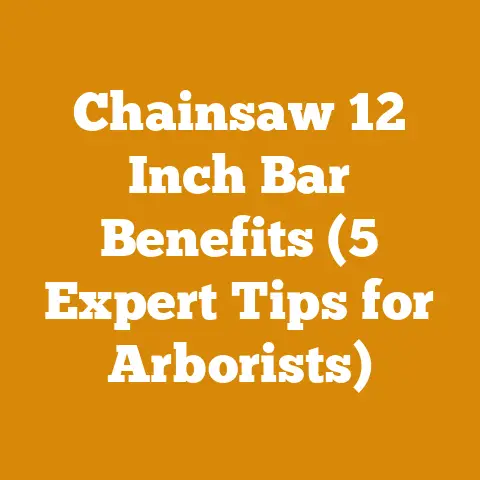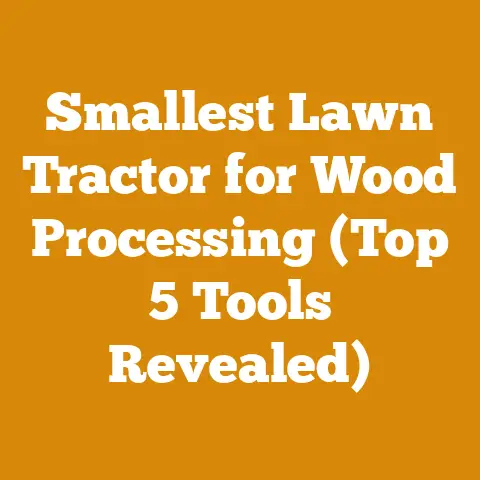Buccaneer Spray for Weed Control in Firewood Yards (Pro Tips)
Alright, let’s dive into the nitty-gritty of weed control in firewood yards, specifically focusing on the use of Buccaneer spray and sharing some pro tips I’ve picked up over years of battling unwanted vegetation in my own wood processing operations.
Introduction: The Weed Wars of the Wood Yard
Picture this: a crisp autumn morning, the smell of freshly cut oak hangs heavy in the air, and a neat stack of firewood awaits its winter destiny. Sounds idyllic, right? Now, imagine that same scene overrun with tenacious weeds, threatening to choke out your neatly organized wood piles and turning your productive space into an unruly jungle. I’ve been there, trust me. It’s a battle as old as firewood itself – the constant struggle against invading weeds.
For years, I’ve been wrestling with weeds in my firewood yard. From the persistent dandelions that seem to pop up overnight to the aggressive grasses that try to weave their way into every crevice, it’s a constant challenge. And let’s not even talk about the thorny vines that try to claim the wood stacks as their own! Over time, I’ve learned that a strategic approach is essential. It’s not just about spraying something and hoping for the best; it’s about understanding the weeds you’re dealing with, choosing the right product, and applying it effectively.
That’s where Buccaneer spray comes in. It’s a tool in my arsenal that I’ve come to rely on, but like any tool, it’s only as effective as the person wielding it. In this article, I’m going to share my experiences, tips, and tricks for using Buccaneer spray to keep your firewood yard weed-free. We’ll cover everything from understanding the active ingredients to proper application techniques, safety precautions, and even some eco-friendly alternatives.
Key Takeaways
Before we get started, here are the main points we’ll be covering:
- Understanding Buccaneer Spray: Know what it is, how it works, and its active ingredients.
- Weed Identification: Learn to identify common weeds in firewood yards and why it matters.
- Application Techniques: Master the art of applying Buccaneer spray effectively and safely.
- Safety First: Understand the necessary precautions to protect yourself and the environment.
- Integrated Weed Management: Discover how to combine Buccaneer spray with other methods for long-term control.
- Eco-Friendly Alternatives: Explore greener options for weed control in your firewood yard.
- Troubleshooting: Learn to diagnose and solve common problems when using Buccaneer spray.
So, grab a cup of coffee, put on your work gloves, and let’s get to work!
Understanding Buccaneer Spray
Before you start spraying, it’s crucial to understand what Buccaneer spray is and how it works. It’s not just a magic potion; it’s a carefully formulated herbicide designed to target specific types of weeds.
What is Buccaneer Spray?
Buccaneer is a non-selective herbicide, meaning it will kill or severely damage most plants it comes into contact with. This is an important distinction because you need to be very careful about where you spray it. It’s typically used for controlling a wide range of broadleaf weeds and grasses in various settings, including agricultural fields, industrial areas, and, yes, firewood yards.
Active Ingredients and How They Work
The active ingredient in Buccaneer is typically glyphosate. Glyphosate works by inhibiting an enzyme essential for plant growth, specifically the enzyme EPSPS (5-enolpyruvylshikimate-3-phosphate synthase). This enzyme is crucial for plants to produce certain amino acids needed for protein synthesis. When glyphosate blocks this enzyme, the plant can no longer produce these essential amino acids, leading to stunted growth, yellowing, and eventually death.
The beauty (and the danger) of glyphosate is that it’s absorbed through the leaves and stems of the plant and then translocated throughout the entire plant, including the roots. This systemic action is what makes it so effective at killing even deep-rooted perennial weeds.
Why Buccaneer?
I’ve tried my fair share of weed control products over the years, and I’ve found Buccaneer to be effective for a few key reasons:
- Broad-Spectrum Control: It tackles a wide variety of weeds, which is essential in a diverse environment like a firewood yard.
- Systemic Action: It kills the entire plant, roots and all, reducing the chance of regrowth.
- Relatively Quick Results: You usually start seeing visible effects within a few days.
Important Considerations
- Non-Selective: Remember, it kills everything it touches. Be extremely careful to avoid spraying desirable plants.
- Environmental Impact: Glyphosate has been a subject of much debate regarding its environmental impact. I’ll discuss this further in the “Eco-Friendly Alternatives” section.
- Resistance: Overuse of glyphosate can lead to weed resistance. It’s important to rotate herbicides and use integrated weed management strategies.
Weed Identification: Know Your Enemy
Before you start spraying, you need to know what weeds you’re dealing with. Not all weeds are created equal, and some are more susceptible to Buccaneer than others. Plus, identifying your weeds can help you understand how they’re spreading and develop a more targeted control strategy.
Common Weeds in Firewood Yards
Here are some of the usual suspects I encounter in my firewood yard:
- Dandelions (Taraxacum officinale): These perennial broadleaf weeds are easily recognizable by their yellow flowers and toothed leaves. They spread by seed and can quickly take over bare soil.
- Crabgrass (Digitaria spp.): This annual grass is a common nuisance in lawns and gardens. It thrives in hot, dry conditions and spreads aggressively by seed.
- Plantain (Plantago spp.): These broadleaf weeds have distinctive ribbed leaves and inconspicuous flowers. They’re often found in compacted soil and can tolerate heavy foot traffic.
- Clover (Trifolium spp.): While some people consider clover a beneficial plant, it can become a weed in a firewood yard, especially if you’re trying to maintain a clean, organized space.
- Thistle (Cirsium spp.): These prickly weeds are a pain to deal with, both literally and figuratively. They have deep roots and can be difficult to eradicate.
- Poison Ivy (Toxicodendron radicans): Okay, poison ivy isn’t technically a weed, but it’s definitely an unwanted guest in any firewood yard. It can cause severe allergic reactions, so it’s important to control it carefully.
Why Identification Matters
- Targeted Control: Some weeds are more susceptible to glyphosate than others. Knowing what you’re dealing with allows you to adjust your application rate and technique accordingly.
- Understanding Spread: Identifying weeds helps you understand how they’re spreading. For example, if you have a lot of dandelions, you know you need to focus on preventing seed dispersal.
- Preventing Future Problems: By identifying weeds early, you can take steps to prevent them from becoming a major problem in the future.
Pro Tip: I keep a weed identification guide handy in my workshop. There are also some great apps you can download to your smartphone that can identify weeds based on a photo.
Application Techniques: The Art of the Spray
Applying Buccaneer spray effectively is more than just pointing and shooting. It’s about understanding the product, the weeds, and the environmental conditions.
When to Spray
The best time to spray Buccaneer is when the weeds are actively growing. This is usually in the spring and fall when temperatures are moderate and there’s plenty of moisture. Avoid spraying on windy days, as the spray can drift and damage desirable plants. Also, avoid spraying when rain is expected within 24 hours, as the rain can wash away the herbicide before it has a chance to be absorbed by the weeds.
Mixing and Dilution
Always follow the manufacturer’s instructions for mixing and dilution. Using too much herbicide can damage the environment, while using too little may not be effective. I typically use a handheld sprayer for spot treatments and a backpack sprayer for larger areas.
Spraying Techniques
- Spot Treatment: For individual weeds or small patches, use a handheld sprayer to apply the herbicide directly to the foliage. Be careful to avoid spraying desirable plants.
- Broadcast Spraying: For larger areas, use a backpack sprayer or a boom sprayer to apply the herbicide evenly over the entire area. This is a more efficient method, but it also carries a higher risk of damaging desirable plants.
- Wick Applicator: For controlling weeds around desirable plants, consider using a wick applicator. This allows you to apply the herbicide directly to the weed without spraying it into the air.
Pro Tips:
- Add a Surfactant: Adding a surfactant (also known as a wetting agent) to the spray solution can help the herbicide stick to the leaves of the weeds and improve its effectiveness.
- Spray in the Morning: Spraying in the morning allows the herbicide to be absorbed by the weeds before the heat of the day causes them to wilt.
- Avoid Overlapping: Overlapping your spray passes can lead to excessive herbicide application and damage to desirable plants.
Safety First: Protecting Yourself and the Environment
Safety should always be your top priority when working with herbicides. Buccaneer spray can be harmful to humans, animals, and the environment if not used properly.
Personal Protective Equipment (PPE)
Always wear the following PPE when handling and applying Buccaneer spray:
- Gloves: Chemical-resistant gloves are essential to protect your skin from exposure to the herbicide.
- Eye Protection: Safety glasses or a face shield will protect your eyes from splashes and sprays.
- Long Sleeves and Pants: Wear long sleeves and pants to minimize skin exposure.
- Respirator: A respirator is recommended when spraying large areas or in enclosed spaces.
Environmental Precautions
- Avoid Spraying Near Water: Do not spray Buccaneer spray near ponds, streams, or other bodies of water. The herbicide can contaminate the water and harm aquatic life.
- Protect Desirable Plants: Cover or shield desirable plants before spraying to prevent them from being damaged by the herbicide.
- Dispose of Empty Containers Properly: Follow the manufacturer’s instructions for disposing of empty herbicide containers. Do not reuse them for any other purpose.
First Aid
- Skin Contact: Wash the affected area with soap and water immediately.
- Eye Contact: Flush your eyes with water for at least 15 minutes.
- Inhalation: Move to fresh air.
- Ingestion: Do not induce vomiting. Seek medical attention immediately.
Integrated Weed Management: A Holistic Approach
Relying solely on Buccaneer spray for weed control is not a sustainable solution. Weeds can develop resistance to glyphosate over time, and the herbicide can have negative impacts on the environment. A better approach is to use integrated weed management (IWM), which combines multiple methods to control weeds in a sustainable way.
Components of Integrated Weed Management
- Prevention: Prevent weeds from entering your firewood yard in the first place. This can be done by cleaning equipment before bringing it onto the property, using weed-free mulch, and promptly removing any weeds that do appear.
- Cultural Practices: Create an environment that favors desirable plants over weeds. This can be done by improving soil drainage, applying fertilizer, and using proper mulching techniques.
- Mechanical Control: Physically remove weeds by hand-pulling, hoeing, or mowing. This is a labor-intensive method, but it can be effective for controlling small infestations.
- Biological Control: Use natural enemies of weeds to control their populations. This can include insects, fungi, or other organisms that feed on or kill weeds.
- Chemical Control: Use herbicides like Buccaneer spray as a last resort, and always follow the manufacturer’s instructions carefully.
My IWM Strategy
Here’s how I incorporate IWM into my firewood yard management:
- Prevention: I’m meticulous about cleaning my logging equipment before bringing it onto my property. I also use weed-free mulch around my wood piles.
- Cultural Practices: I make sure my soil is well-drained and I apply compost regularly to improve soil health.
- Mechanical Control: I spend a few hours each week hand-pulling weeds and mowing the grass around my wood piles.
- Chemical Control: I only use Buccaneer spray for spot treatments of particularly stubborn weeds that I can’t control with other methods.
Eco-Friendly Alternatives: Going Green
If you’re concerned about the environmental impact of glyphosate, there are several eco-friendly alternatives you can use for weed control in your firewood yard.
Non-Chemical Options
- Manual Removal: Hand-pulling or hoeing weeds is the most eco-friendly option, but it’s also the most labor-intensive.
- Mulching: Mulch smothers weeds and prevents them from germinating. Use organic mulches like wood chips, straw, or shredded leaves.
- Solarization: Cover the soil with clear plastic for several weeks during the summer to kill weeds with heat.
- Vinegar: Horticultural vinegar (acetic acid) can be used to kill weeds, but it’s not as effective as glyphosate and may require multiple applications.
- Boiling Water: Pouring boiling water on weeds can kill them, but be careful not to splash it on desirable plants.
- Flame Weeding: Using a propane torch to burn weeds can be effective, but it’s also a fire hazard and should be used with caution.
Organic Herbicides
- Herbicidal Soaps: These products contain fatty acids that disrupt the cell membranes of weeds, causing them to dry out and die.
- Citrus Oil Herbicides: These products contain d-limonene, a natural compound found in citrus peels that can kill weeds.
- Clove Oil Herbicides: These products contain eugenol, a natural compound found in clove oil that can kill weeds.
Important Considerations
- Effectiveness: Eco-friendly alternatives may not be as effective as glyphosate, especially for controlling perennial weeds.
- Cost: Some eco-friendly alternatives can be more expensive than glyphosate.
- Safety: Even eco-friendly alternatives can be harmful if not used properly. Always follow the manufacturer’s instructions carefully.
Troubleshooting: Solving Common Problems
Even with the best planning and execution, you may encounter problems when using Buccaneer spray. Here are some common issues and how to solve them:
Problem: Weeds Aren’t Dying
- Possible Causes:
- Incorrect dilution rate
- Weeds are resistant to glyphosate
- Weeds are not actively growing
- Rain washed away the herbicide
- Solutions:
- Double-check the dilution rate and make sure you’re using the correct amount of herbicide.
- Try a different herbicide with a different mode of action.
- Wait until the weeds are actively growing before spraying.
- Avoid spraying when rain is expected within 24 hours.
Problem: Desirable Plants Are Damaged
- Possible Causes:
- Herbicide drifted onto desirable plants
- Herbicide was applied too close to desirable plants
- Herbicide was absorbed through the roots of desirable plants
- Solutions:
- Avoid spraying on windy days.
- Use a shield or cover to protect desirable plants before spraying.
- Avoid spraying near the root zone of desirable plants.
Problem: Herbicide is Clogging the Sprayer
- Possible Causes:
- Herbicide was not properly mixed
- Herbicide is old or contaminated
- Sprayer is dirty or clogged
- Solutions:
- Mix the herbicide thoroughly before adding it to the sprayer.
- Use fresh herbicide and store it properly.
- Clean the sprayer thoroughly after each use.
Bonus Tip: I always keep a spare sprayer on hand in case one breaks down or gets clogged. It’s a small investment that can save you a lot of time and frustration.
Conclusion: Winning the Weed Wars
Controlling weeds in a firewood yard is an ongoing battle, but with the right tools and strategies, you can keep your wood piles clean and organized. Buccaneer spray can be a valuable weapon in your arsenal, but it’s important to use it responsibly and in conjunction with other weed management methods. Remember to always prioritize safety and consider the environmental impact of your choices.
By understanding the weeds you’re dealing with, applying Buccaneer spray effectively, and using integrated weed management techniques, you can win the weed wars and create a productive and aesthetically pleasing firewood yard.
So, go forth and conquer those weeds! And remember, a little bit of prevention and proactive management can go a long way in keeping your firewood yard weed-free. Now, if you’ll excuse me, I have some dandelions to hunt down.






